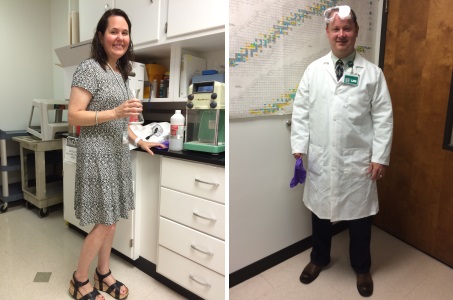The basic "ensemble" consists of a shirt, long pants or skirt which reaches the ankles, closed toe shoes made of nonabsorbent material, nitrile gloves, and a buttoned lab coat with long sleeves. Sadly, the shorts and sandals that make our Alabama summers more bearable, don’t provide the protection necessary for safe work around potentially hazardous materials. A set of economical scrubs and work shoes stored in your desk or gym bag may be the answer.

Examples of improper personal protective equipment (PPE), left, and proper PPE, right
This basic outfit should be "accessorized" with additional personal protective equipment (PPE) depending on the task and agents being used.
Work with chemicals or biological agents may require the use of splash goggles or safety glasses for eye protection. A face shield may be used if there is a need for enhanced protection of the face. Check your lab’s standard operating procedures for more information on the hazards of your protocol.
Steel toed shoes or work boots may be needed for work around heavy equipment and tools.
If pyrophoric chemicals, solvents or hot processes are part of your research, then you may need to wear a fire-retardant or all cotton lab coat and avoid any synthetic clothing that could melt to your skin if a fire occurred.
Handling of cryogenic liquids, such as liquid nitrogen, requires the addition of specialized gloves and a face shield.
A word about those gloves:
Gloves may be needed to protect the person from the work, the work from the person, or both! Good glove choices require all the facts. Check your departmental protocols before starting work. Check with your vendors to see which price, flexibility and durability option fits best with your work.
Chemical Agents
When working with chemicals, the glove material becomes very critical. Thin latex gloves offer very little protection against chemicals. They may be adequate if weak water based solutions are used and the primary task hazard is biological in nature. But, if you are working with organic solvents, latex is no protection at all and may trap solvent against your skin and make the exposure worse! (Or the glove may dissolve completely). Nitrile or butyl rubber would be a better choice. The attached table and Material Safety Data Sheets from the chemical you will be using are guides to help in the selection of proper gloves for the task. Silver shield gloves provide excellent protection even against very "aggressive" materials like methylene chloride, but keep in mind that they are expensive, not very good for jobs requiring fine dexterity and may be unnecessary.
A Word about Glove Etiquette
Only wear gloves when and where they are needed. Take the gloves off when you finish the task that required them. If you handle something toxic or infectious and then walk down the hall touching doors and elevator buttons, you put others at risk of exposure. Even if your gloves are clean, the perception is that the gloves are dirty.
Resistance to Chemicals of Common Glove Materials
(E=Excellent, G=Good, F=Fair, P=Poor)
| Chemical Name | Latex | Neoprene | Nitrile | Vinyl |
| Acetaldehyde | G | G | E | G |
| Acetic acid | E | E | E | E |
| Acetone | G | G | G | F |
| Acrylonitrile | P | G | n/a | F |
| Ammonium hydroxide | G | E | E | E |
| Aniline | F | G | E | G |
| Benzaldehyde | F | F | E | G |
| *Benzene | P | F | G | F |
| *Benzyl chloride | F | P | G | P |
| Bromine | G | G | n/a | G |
| Butane | P | E | n/a | P |
| Butyraldehyde | P | G | n/a | G |
| Calcium hypochlorite | P | G | G | G |
| Carbon disulfide | P | P | G | F |
| *Carbon tetrachloride | P | F | G | F |
| Chlorine | G | G | n/a | G |
| Chloroacetone | F | E | n/a | P |
| Chloroform | P | F | G | P |
| Chromic acid | P | F | F | E |
| Cyclohexane | F | E | n/a | P |
| Dibenzyl ether | F | G | n/a | P |
| Dibutyl phthalate | F | G | n/a | P |
| Diethanolamine | F | E | n/a | E |
| Diethyl ether | F | G | E | P |
| **Dimethyl sulfoxide | n/a | n/a | n/a | n/a |
| Ethyl acetate | F | G | G | F |
| *Ethylene dichloride | P | F | G | P |
| Ethylene glycol | G | G | E | E |
| *Ethylene trichloride | P | P | n/a | P |
| Fluorine | G | G | n/a | G |
| Formaldehyde | G | E | E | E |
| Formic acid | G | E | E | E |
| Glycerol | G | G | E | E |
| Hexane | P | E | n/a | P |
| Hydrobromic acid (40%) | G | E | n/a | E |
| Hydrochloric acid | G | G | G | E |
| Hydrofluoric acid (30%) | G | G | G | E |
| Hydrogen peroxide | G | G | G | E |
| Iodine | G | G | n/a | G |
| Methylamine | G | G | E | E |
| Methyl cellosolve | F | E | n/a | P |
| *Methyl chloride | P | E | n/a | P |
| Methyl ethyl ketone | F | G | G | P |
| *Methylene chloride | F | F | G | F |
| Monoethaloamine | F | E | n/a | E |
| Morpholine | F | E | n/a | E |
| *Naphthalene | G | G | E | G |
| Nitric acid | P | P | P | G |
| Perchloric acid | F | G | F | E |
| Phosphoric acid | G | E | n/a | E |
| Potassium hydroxide | G | G | G | E |
| *Propylene dichloride | P | F | n/a | P |
| Sodium hydroxide | G | G | G | E |
| Sodium hypochlorite | G | P | F | G |
| Sulfuric acid | G | G | F | G |
| *Toluene | P | F | G | F |
| *Trichloroethylene | P | F | G | F |
| Tricresyl phosphate | P | F | n/a | F |
| Triethanolamine | F | E | E | E |
| Trinitrotoluene | P | E | n/a | P |
* Aromatic and halogenated hydrocarbons will attack all types of natural and synthetic glove materials.
** No data on the resistance to dimethyl sulfoxide of natural rubber, neoprene, nitrile rubber, or vinyl materials are available; the manufacturer of the substance recommends the use of butyl rubber gloves.
** No data on the resistance to dimethyl sulfoxide of natural rubber, neoprene, nitrile rubber, or vinyl materials are available; the manufacturer of the substance recommends the use of butyl rubber gloves.
Taken from "Prudent Practices for Handling Hazardous Chemicals in the Laboratory."
Glove suppliers
Ansell-Edmont Hand Protection
Northern Safety Supply
More PPE information
OSHA eye and face protection e-tool
